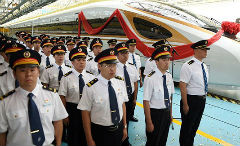China’s Fuxing bullet trains to restore 350 kmh speed
2017-07-28
Xinhua
BEIJING — China started tests on July 27 to restore the maximum speed of the Beijing-Shanghai high-speed bullet train to 350 kilometers per hour, six years after it was reduced to 300.
Departing Beijing South Railway Station at 8:38 a.m., a Fuxing bullet train completed the round-trip from Beijing to Xuzhou in East China’s Jiangsu province, about 700 kilometers away, in about four hours.
The speed hike will cut the Beijing-Shanghai journey to about 4.5 hours, about half an hour faster than the current minimum.
The test will pave way for a new schedule on the Beijing-Shanghai railway starting mid-September.
Connecting the Chinese capital with its major financial and trade hub, the Beijing-Shanghai high-speed railway is one of the busiest in the country, carrying over 100 million passengers a year.
The test on July 27 showed that energy consumption on the Fuxing decreased to 10 percent less than on the Hexie train (CRH380) when running at a speed of 350 kilometers per hour.
“The Beijing-Shanghai high speed railway is built to the highest standard in the world, while the Fuxing is designed and manufactured with an operating speed of 350 kilometers per hour. It is out of question for Fuxing to run on the Beijing-Shanghai line at such a speed from the point of view of technical safety, reliability and comfort,” said Lu Dongfu, general manager of China Railway Corporation.
China started to run its first 350-kmh high speed train between Beijing and Tianjin in Aug. 2008 and opened at least three more such high speed lines nationwide in the following years, until the authorities ordered speeds to be cut to between 250-300kmh in 2011.
China’s Fuxing bullet trains were unveiled in June and are capable of top speeds of 400 kmh.
“The Fuxing was designed and manufactured in China, led by the China Railway Corporation. We hold the complete intellectual property rights of the new bullet trains — electric multiple units (EMU) -- which have reached the world’s advanced level,” said He Huawu of the China Academy of Engineering.
The new EMU has completed 600,000 kilometers of running assessment and increased the design life to 30 years from 20, according to He.
The Fuxing has a monitoring system that slows the train in case of emergency or abnormal conditions. Telemetry allows a control center to monitor the train in real time.
The Fuxing, meaning rejuvenation, is a substantial upgrade on the Hexie, which means harmony. The Fuxing is more spacious and energy-efficient, with a longer life expectancy and better reliability.
There will be a process for China to consider whether to speed up its whole high-speed network, though such a move may pose a challenge to railway management, He said, adding that the financial and social benefits must be considered.
Take the Fuxing as an example, energy consumption would increase 20-30 percent if the train improved its speed from 300kmh to 350, according to Du Yanliang of the China Academy of Engineering.
However, the speed hike will improve social benefits, as it will help ease ticket shortages on the busy Beijing-Shanghai line and save time for passengers.
China will open seven Fuxing trains in either direction of the Beijing-Shanghai line in its initial stage. The ticket price will not change.
The authorities will gradually increase the number of the new bullet train and adjust ticket prices in future, He said.
China has the world’s longest high-speed rail network, 22,000 kilometers at the end of last year, or about 60 percent of the world’s total.
About one-third of China’s high-speed railways were designed to run at a speed of 350 kmh, according to He.
Several countries, including Indonesia, Russia and India, have bought Chinese bullet trains.


